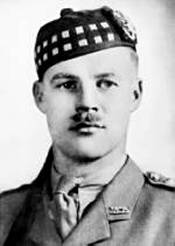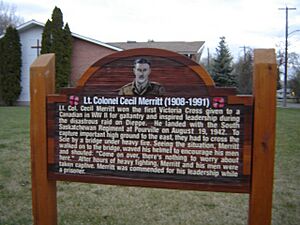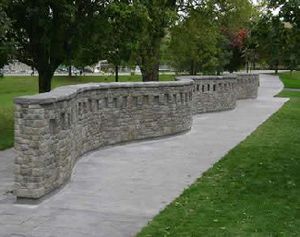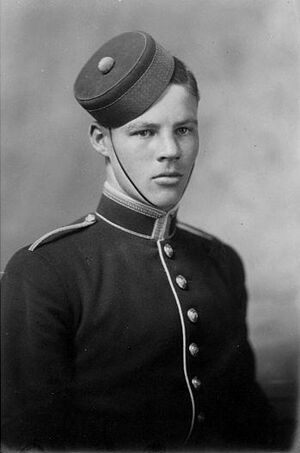Charles Merritt facts for kids
Quick facts for kids
Charles Cecil Ingersoll Merritt
|
|
|---|---|

Photo of Charles Merritt from The Times
|
|
| Member of the Canadian Parliament for Vancouver—Burrard |
|
| In office 1945–1949 |
|
| Preceded by | Gerry McGeer |
| Succeeded by | Lorne MacDougall |
| Personal details | |
| Born | 10 November 1908 Vancouver, British Columbia, Canada |
| Died | 12 July 2000 (aged 91) Vancouver, British Columbia, Canada |
| Political party | Progressive Conservative |
| Awards | Victoria Cross Mentioned in Despatches Efficiency Decoration |
| Military service | |
| Allegiance | Canada |
| Branch/service | Canadian Army |
| Years of service | 1929–1945 |
| Rank | Lieutenant Colonel |
| Commands | The South Saskatchewan Regiment |
| Battles/wars | World War II |
Charles Cecil Ingersoll Merritt was a brave Canadian soldier. He won the Victoria Cross, which is the highest award for courage in battle. He also became a Member of Parliament for Canada.
Contents
Early Life and Education
Charles Merritt was born in Vancouver, British Columbia, on November 10, 1908. His father, Captain Cecil Mack Merritt, died in battle during World War I in 1915.
When Charles was 16, he joined the Royal Military College of Canada in 1925. He studied hard and graduated with high marks.
Becoming a Soldier and Lawyer
In 1929, Merritt became an officer in a military group called the Seaforth Highlanders of Canada. At the same time, he studied law and became a lawyer in 1932. He worked as a lawyer in Vancouver until World War II began.
Military Service in World War II
When the war started, Merritt was promoted to major. He sailed to England in December 1939. For the next two years, he worked in different army jobs. He also took a special course for army leaders.
In 1942, he became the leader of The South Saskatchewan Regiment. Two months later, his regiment moved to the Isle of Wight. They trained there for a big mission called the Dieppe Raid.
The Dieppe Raid
Merritt led his regiment during the Dieppe Raid on August 19, 1942. This was a tough battle. Before he was captured, Merritt was wounded twice. He showed amazing bravery and leadership. Because of this, he was given the Victoria Cross.
The plan for the raid was complex. Two British commando groups landed early to destroy German guns. Two Canadian groups were supposed to land next to help.
Merritt's group, the South Saskatchewan Regiment, landed at a place called Green Beach. Their goal was to capture the cliffs above a village called Pourville.
Crossing the River Scie
His soldiers crossed the English Channel in navy ships. They then got into smaller landing boats. They reached Green Beach on time, in the dark, and without being attacked at first.
However, most of his soldiers landed on the wrong side of the Scie River. They had to cross a narrow bridge in Pourville to reach their goals.
The German soldiers quickly realized what was happening. They started firing machine guns and mortars at the bridge. It was very dangerous to cross.
Merritt saw that his men were struggling. He bravely led the next charge forward. He waved his helmet and shouted, "Come on over. There's nothing to it!"
His courage surprised the enemy. Some men followed him across the bridge, and others used the bridge's metal beams to cross. Merritt got most of his surviving men to the other side. But they couldn't go further because they ran out of supplies and couldn't talk to the ships for help.
Fighting the Enemy
Merritt's group faced strong enemy bunkers made of concrete. He led attacks on each one. He even personally attacked one bunker, throwing grenades inside to defeat the enemy.
After the last enemy strong point was silenced, Merritt had been wounded twice. His group had fewer than 300 men left.
He held a temporary safe area and kept in touch with his soldiers. He moved around to check on them, even after his messengers were killed.
Withdrawal and Capture
When it was time to leave the beach, Merritt calmly told his men how to pull back safely. He announced that he would stay behind to protect them. He held a position near the beach to cover their escape.
The South Saskatchewan Regiment lost 84 men on Green Beach. Another 89 men, including Merritt and eight other officers, were captured.
His award description for the Victoria Cross said that his personal bravery helped his unit succeed. It also said that a large part of his unit was able to get back safely because of him.
Prisoner of War
Merritt was sent to a prison camp called Oflag VII-B in Germany. In June 1943, he and 64 others escaped through a 120-foot tunnel. But they were all caught again after a big search.
Merritt was put in solitary confinement for 14 days. Then he was moved to another prison camp, Colditz Castle. After he was freed, he said his war only lasted six hours. He felt that many other Canadians fought much longer. He didn't think his time as a prisoner was special.

Several streets in Regina, Saskatchewan, are named after Merritt. These include Charles Crescent, Cecil Crescent, Ingersoll Crescent, and Merritt Crescent.
A road in Windsor, Ontario, is also named Merritt Drive. This city provided soldiers for another regiment that fought at Dieppe.
Life After the War
After leaving the army in 1945, Merritt became a Member of Parliament. He represented the area of Vancouver—Burrard from 1945 to 1949.
He then returned to Vancouver and continued his law practice. He also served as the leader of the Seaforth Highlanders of Canada again from 1951 to 1954. Later, he was an honorary leader for the regiment.
Merritt was also a valued rugby player for the Meraloma Rugby Club.
Family Life
In 1937, Charles Merritt married Grace Graham. They had two sons and one daughter.
Death and Legacy
LCol Merritt passed away in Vancouver on July 12, 2000, at the age of 91. He was buried at Ocean View Cemetery in Burnaby, British Columbia.
Medals and Honours
Merritt's medals, including his Victoria Cross, were given to the Canadian War Museum in Ottawa after his death.

Merritt is listed on the Wall of Honour at the Royal Military College of Canada in Kingston, Ontario.
The bridge over the Scie River in Pourville, where Merritt showed his bravery, was renamed in his honour in 1992. This was for the 50th anniversary of the Dieppe Raid.
In 2017, a flight (a group of cadets) at the Royal Military College of Canada was renamed Merritt Flight to honour him.
Images for kids
-
Lt. Col Cecil Merritt plaque at the corner of Merritt St. & Rockingham Ave. in Saskatoon's Montgomery Place neighborhood.
-
Wall of Honour, Royal Military College of Canada







